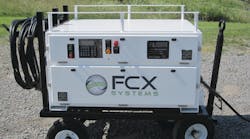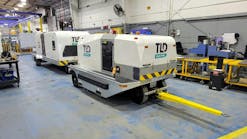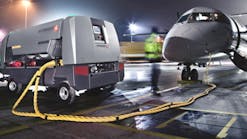Point-Of-Use versus Central Systems for 400Hz Power/PC Air
By: Bryan Bullerdick, V.P. Sales & Marketing, FCX Systems, Inc.
I have been involved in the aviation industry for 17 years, first as a FBO and Flight School FAR part 141 and 135 Pilot, as an airline pilot, and now as VP of sales and marketing for FCX Systems, Inc., a manufacturer of aircraft power and air-conditioning systems. One of the more interesting debates in which many of my FCX colleagues and I have been involved is central aircraft power and air delivery systems versus point-of-use (POU) delivery systems. While absolutely every project is different, there are basic principles to these two approaches that, once understood, may prove beneficial in planning your next project.
The idea that POU can be a catch-all design for all sizes and types of projects stems from outdated information on technologies, concern with capital limitations, or general misunderstandings of central system designs. POU delivery systems are defined as systems where each aircraft service position has a self-contained, independent, power and PC Air unit. This approach is usually economical up to 10 units. At about 10 service points and above, the argument to look at central power and air technologies begins to become more attractive.
The first point to consider is the distance between aircraft service points and the possible location of the POU equipment. POU units have limitations in distance. A 400HZ, 200/115 volt output has a relatively high voltage drop and suffers quality on long cable runs. In the case of POU PC Air units (DX type), normal output temperature of just above freezing at the output of the unit can suffer temperature rise in long ducting runs. The idea of POU equipment is to be as close to the aircraft as possible. Similar to a commercial airport terminal where each passenger boarding bridge (PBB) would have POU units on the PBB in close proximity to the aircraft, an aircraft hangar POU system would have either cart units or stationary wall units located near the designated aircraft service points.
The limitations on distance alone between the POU units and the service points may dictate the technology decision because central power and air tends to be better suited, not only for longer cable and hose ducting that runs to aircraft service locations, but also for more expansive layouts in the case of aircraft hangars and ramps. In many cases vast ramp spaces, terminals and hangars need multiple service points that are very far apart. In these cases, central 400Hz, 312KVA-1000KVA type units with a higher voltage output (575V or 1000V) paralleled together to get a total KVA requirement allows for much longer cable runs. Central PC Air systems operate in the same manner, in that chiller systems, pumps and other accessories are sized to meet the specific distance requirements. Power and PC Air central systems both require additional equipment near the aircraft service points, like a Line Drop Compensator (LDC) to convert the higher voltage to acceptable 200/115 vac 400Hz aircraft power, or air handler units (AHU) to convert the hot or cold glycol/water to hot or cold air to the aircraft. These additional items are generally much smaller and lighter when compared to the self-contained POU units.
The design parameters for central PC Air and power are similar, and if all else is equal, at about 10 aircraft service points, the cost for a central system starts to become more attractive. There are several reasons for this, but the most compelling reason for considering central systems is simple efficiency. Central systems, in most cases, have a lower rate of power consumption to do the same work as POU systems. In addition, the life expectancy on average increases and maintenance costs decrease, as compared with POU units. The down side to the central systems approach is that there is a larger upfront investment. However, in recent years there has been keen competition among the manufacturers of central systems equipment, which has effectively served to tighten the pricing differences between POU and central system technologies.
Whether POU or Central Systems, it is wise to consider an investment in systems where efficiencies in delivery of power and PC Air reduces APU usage. The following graphs depict an average installation situation which can be used to compare the differences between central and POU 400Hz systems.
The graphs above show that POU systems have a lower initial cost until about 10 service points, but the maintenance costs are higher than that for central systems. It is also clear that the operational savings are similar up until 10 service points, and then central system 400Hz begins to become the larger cost savings system. The reason for this is that true central equipment is too large and cumbersome for the less than 10 service points, which means that maintenance and operations costs will be excessive for the capabilities and services received. There are still reasons to use central 400Hz systems on small projects. One example would be a 400 Hz system design that includes long cable runs where voltage drop is a problem. Another example would be where a designer needs to consider planning for future capabilities.
The graphs above are all based on 400Hz units. The same argument is congruent with the PC Air central systems versus POU systems, except that the numbers would be approximately doubled what is represented on these 400Hz graphs. This also means that the operational savings between the two systems would double as well.
In considering which technology would be chosen for your next project, I would strongly recommend beginning by calling a manufacturer or consultant who clearly understands both technologies and is not biased to one or the other based on manufacturing limitations or preference. There are several engineering firms who are excellent in producing cost analysis for these systems and who can also take into account other specific factors which will drive a decision between these two technologies. Because of improved competition over the last few years and other advancements in the central system technologies, I invite you to consider this article as a starting point as you consider either solution. The only wrong solution is to run the aircraft’s APU which costs a lot more than investing in electric power and air.






